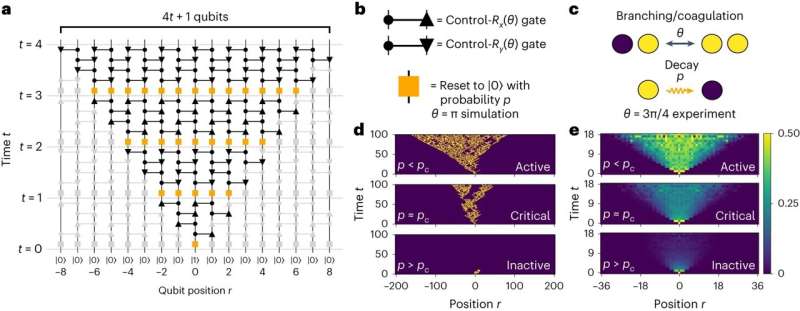Driving dissipative quantum circuits. Credit: natural physics (2023). DOI: 10.1038/s41567-023-02199-w
With support from the Department of Energy’s Oak Ridge National Laboratory’s Quantum Computing User Program (QCUP), researchers simulated key quantum states at one of the largest scales ever reported.
The team used technology that could help develop quantum simulation capabilities for next-generation quantum computers.
The research used Quantinuum’s H1-1 computer to model quantum versions of classical mathematical models that track how diseases spread. The computer time is provided by QCUP, part of the Oak Ridge Leadership Computing Facility, which awards time to private quantum processors across the country to support research projects.
The model uses qubits to simulate transitions between active states (such as infection) and inactive states (such as death or recovery).
“The goal of this research is to try to build capabilities on quantum computers to solve this and other similar problems that are difficult to compute on classical computers,” said study co-author Andrew Potter, assistant professor of physics.
“This experimental model attempts to guide a quantum system to a specific state while competing with quantum fluctuations away from that state. There is a transition point where these competing effects are completely balanced. This point separates the stages of successful and failed guidance.”
The further the system deviates from equilibrium, the more likely it is that the classical version of the model will break down due to the size and complexity of the equations. The research team sought to use quantum computing to simulate these dynamics.
Classic computers store information in bits equal to 0 or 1. Such binary dynamics are not necessarily suitable for modeling transitional states, such as those studied in disease models.
Quantum computing uses the laws of quantum mechanics to store information in qubits (the quantum equivalent of bits). Qubits can exist in multiple states at the same time through quantum superposition, which allows qubits to carry more information than classical bits.
In quantum superposition, a qubit can exist in two states at once, similar to a spinning coin—the coin is neither heads nor tails, and the qubit is neither one frequency nor the other. Measuring the value of a qubit determines the probability of measuring one of two possible values, similar to stopping a coin on heads or tails. This dynamic allows for a wider range of possible values and can be used to study complex problems such as transition states.
Researchers hope these possibilities will fuel a quantum revolution, allowing quantum computers to surpass classical machines in speed and power. However, the qubits used in current quantum machines tend to degrade easily. This attenuation results in high error rates that can confound the results of any model larger than the test problem.
Potter and his colleagues obtained the timing using QCUP on the Quantinuum computer, which uses trapped ions as qubits. They measured the circuit, or quantum gate, throughout the run and used a technique called qubit recycling to eliminate degraded qubits.
“We use quantum processors to simulate a system in which an active qubit can activate neighboring qubits or become inactive,” Porter said. “By monitoring the system in real time and performing tests at each step, we can detect the possibility that performing a quantum gate on a qubit may affect the state of the qubit, and if not, remove it from the calculation. This way , we can avoid the chance of errors.
The team determined that they could use their method on 20 qubits to suppress errors and simulate quantum systems nearly four times the size. They estimate that their method could equal or exceed the capabilities of classical computers at 70 qubits.
“This is the first time this approach has been used on a system of this scale,” Porter said.
Next steps include applying qubit recycling to quantum problems, such as simulating the properties of a material and calculating its lowest energy state, or quantum ground state.
Paper published in journal natural physics.
More information:
Eli Chertkov et al., Characterizing nonequilibrium phase transitions on a quantum computer, natural physics (2023). DOI: 10.1038/s41567-023-02199-w
Provided by Oak Ridge National Laboratory
citation: Moving to large-scale quantum simulation (2024, April 22) Retrieved April 22, 2024, from https://phys.org/news/2024-04-quantum-simulation-scale.html
This document is protected by copyright. No part may be reproduced without written permission except in the interests of fair dealing for private study or research purposes. Content is for reference only.
#Moving #largescale #quantum #simulations
Image Source : phys.org
